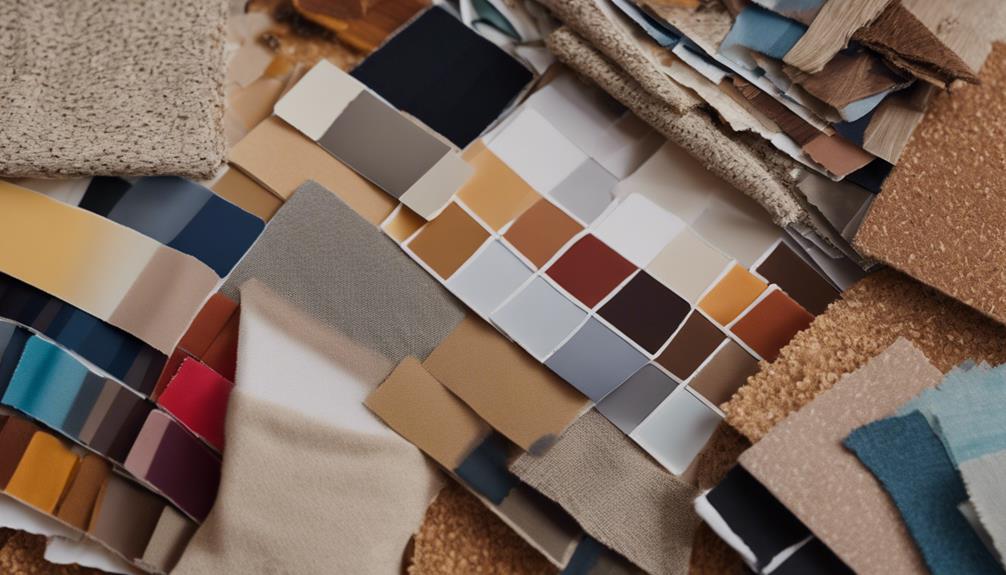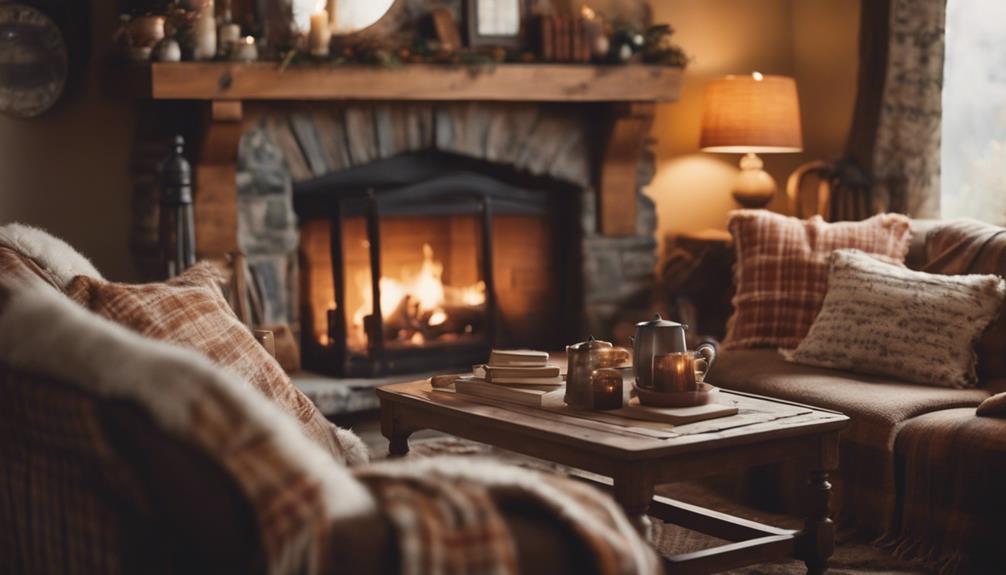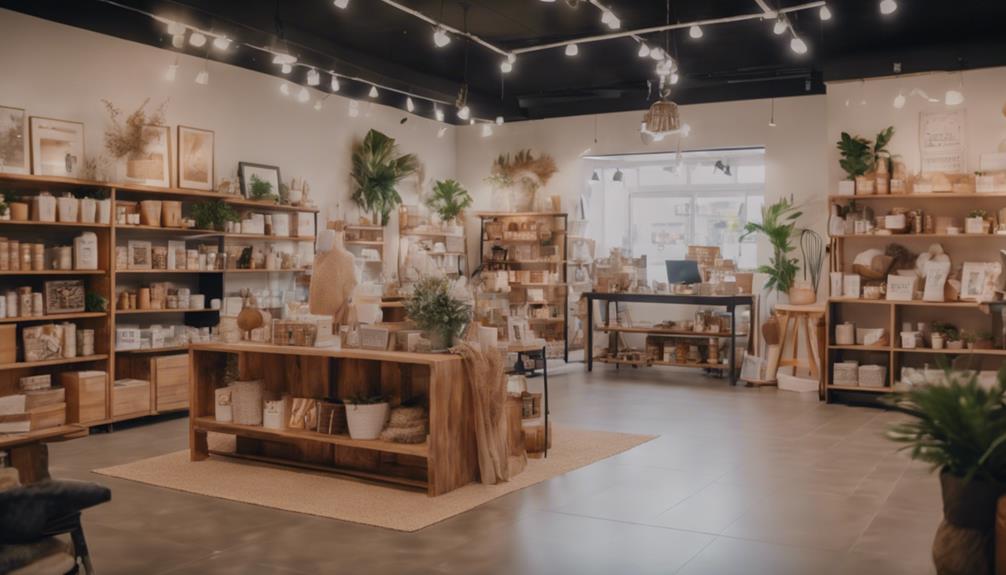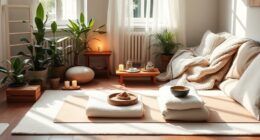Create a captivating mood board for your home decor to achieve the perfect design. Pay close attention to important elements like color palettes and textures to effectively communicate your vision. Take advantage of platforms like Canva or Pinterest for easy creation and organization. Incorporate furniture, fabrics, and accessories to capture the desired aesthetic. Arrange all components harmoniously and experiment with different layouts for the optimal composition. Elevate your design with strategic color selections for a visually pleasing space. Immerse yourself in the world of mood boards to streamline your design process and maintain organized elements, ensuring a visually appealing environment that aligns with your personal style and vision.
Key Takeaways
- Gather design inspiration from various sources like magazines and online platforms.
- Focus on key elements such as colors, textures, furniture, and accessories.
- Utilize tools like Canva for easy layout creation and organization.
- Ensure cohesive composition by harmonizing textures, patterns, and colors.
- Create a visually engaging mood board that reflects your unique design vision.
Understanding Mood Boards
To grasp the concept of mood boards, envision them as visual collages that capture the essence of design ideas through images, materials, and colors.
In an interior design project, design mood boards play a pivotal role in conveying the overall look and feel of a space. These boards aren't just random collections of images but carefully curated representations that help organize design elements and gather inspiration.
When working on an interior design project, creating mood boards is essential for effective communication and visualization. They serve as a reference point for decision-making and enable seamless collaboration with clients.
Creating a Mood Board

You can start creating your mood board by focusing on key elements, like color schemes and textures.
The layout of your mood board is essential in conveying your design vision effectively.
Look for inspiration in magazines, online platforms, or even nature to kickstart your creative process.
Key Mood Board Elements
Consider including a variety of images showcasing furniture, fabrics, paint swatches, and accessories on your home decor mood board. Incorporating textures, patterns, and colors that align with the desired aesthetic of the room is vital. Making a mood board for decor allows you to visually organize and see how different elements work together. It can also help you make more informed decisions when it comes to purchasing items for the room. By including a variety of images, you can ensure that the overall look is cohesive and visually appealing.
Utilize platforms like Canva or Pinterest to easily create and organize your design boards online. Make sure your mood board vividly captures the overall theme and style you aim to achieve in your home decor project.
To effectively convey your design vision, keep your mood board visually appealing and cohesive. By combining different elements like furniture pieces, fabric samples, paint swatches, and decor accents, you can create a detailed representation of your design concept.
Remember to select images that harmonize well together to portray a unified and harmonious design scheme. This will help you visualize how different elements will come together in your space and guide you in achieving the perfect look for your home.
Mood Board Layout
How can you effectively arrange images, textures, colors, and furniture samples on a mood board to convey your desired design aesthetic?
When creating a mood board layout to visualize and create an interior design, consider utilizing tools like Canva for easy drag-and-drop functionality.
Start by incorporating a mix of images, textures, colors, and furniture samples in a visually appealing manner. Arrange these elements in a cohesive layout to convey the specific design aesthetic you aim for.
Utilize text overlays to label and describe each component on the mood board effectively. Experiment with various layouts to discover the most compelling composition that aligns with your design vision.
Mood Board Inspiration
Creating a mood board serves as a powerful tool for gathering visual inspiration and conveying design ideas for your home decor project. When seeking mood board inspiration, consider incorporating colors, textures, and furnishings that resonate with your vision. Platforms like Canva and Pinterest are excellent resources for creating digital mood boards that capture your design process.
These boards not only help you explore different styles but also keep everyone involved in the design process aligned and on the same page. To enhance your design concept, include textiles, color palettes, furniture, and decor elements that spark creativity and cohesion. Utilizing tools such as Google spreadsheets and Pinterest boards can streamline the sourcing and organization of these design elements, making the design process more efficient and enjoyable.
Embrace the freedom to explore various inspirations and let your mood board guide you towards achieving the perfect design for your home decor project. You can find a multitude of home decor inspiration on Pinterest, from traditional designs to modern aesthetics. By curating a collection of images that resonate with you, you can begin to identify common themes and styles that you can incorporate into your own space. Allow yourself to be open to new ideas and don’t be afraid to mix and match different elements to create a unique and personalized look for your home.
Digital Mood Board Templates

Digital mood board templates in Canva offer a convenient and user-friendly way to design customized mood boards for your home decor projects. Canva provides a range of digital mood board templates that cater to various interior design styles. These templates come equipped with pre-designed layouts and elements, simplifying the customization process.
You have the flexibility to select from different styles, colors, and themes to align with your design vision. The customizable features in Canva's templates enable you to personalize your mood board to reflect your unique taste and preferences. Whether you're new to design or an experienced creator, Canva's digital mood board templates are designed to be user-friendly, making them ideal for all skill levels.
With Canva's intuitive platform and diverse template options, you can easily craft visually appealing mood boards that capture the essence of your desired home decor style.
Using Pinterest for Mood Boards

You can use Pinterest to create mood boards by gathering images of textiles, color palettes, furnishings, and decor elements in one place.
Pinterest boards serve as visual references for your design projects, helping you keep all design elements organized and accessible.
This platform allows for easy sourcing and saving of links for materials and products, streamlining the design process and making online shopping convenient.
Pinterest Board Basics
Consider utilizing Pinterest boards as a convenient tool for creating digital mood boards when starting on home decor projects. Pinterest serves as a versatile platform where you can compile images, links, and ideas to construct your interior design mood board.
To begin, create a mood board template on Pinterest by including textiles, color schemes, furniture pieces, and decor items that resonate with your design vision. This digital mood board not only aids in organizing your inspirations but also acts as a visual reference point throughout your project.
Pinterest offers a user-friendly interface for easy organization and sourcing of design inspiration. Save various pins to your board to streamline the design process and gather a detailed collection of ideas.
Mood Board Elements
When creating mood boards on Pinterest for your home decor projects, make sure to include a diverse range of elements such as textiles, color schemes, furniture pieces, and decor items to capture your design vision effectively.
Pinterest serves as a valuable platform for organizing these elements into a cohesive design board. By saving links on your Pinterest mood board, you can easily reference and even shop online for the items you've included.
Including images of materials, furnishings, and accessories on your Pinterest board not only provides visual inspiration but also acts as a handy sourcing tool for home decor ideas.
With Pinterest's user-friendly interface, you can effortlessly curate a collection of design elements that align with your style preferences, making the process of creating a mood board an enjoyable and efficient part of your home decor planning.
Organizing Design Elements
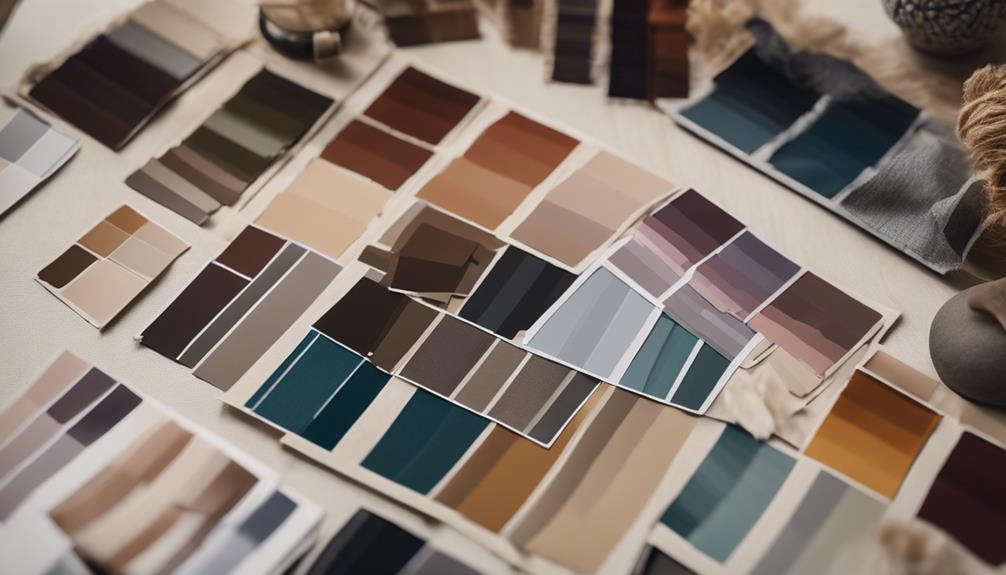
To effectively organize design elements for your home decor mood board, utilize categories like textiles, color palettes, furnishings, and accessories. By categorizing your design elements, you can create a cohesive and visually appealing mood board that reflects your style and vision. Here is a table to help you organize your design elements effectively:
| Category | Examples |
|---|---|
| Textiles | Fabrics, rugs, curtains |
| Color Palettes | Swatches, paint samples |
| Furnishings | Furniture, lighting fixtures |
| Accessories | Decorative items, artwork |
| Sources | Websites, stores, inspiration |
Tracking Links and Prices
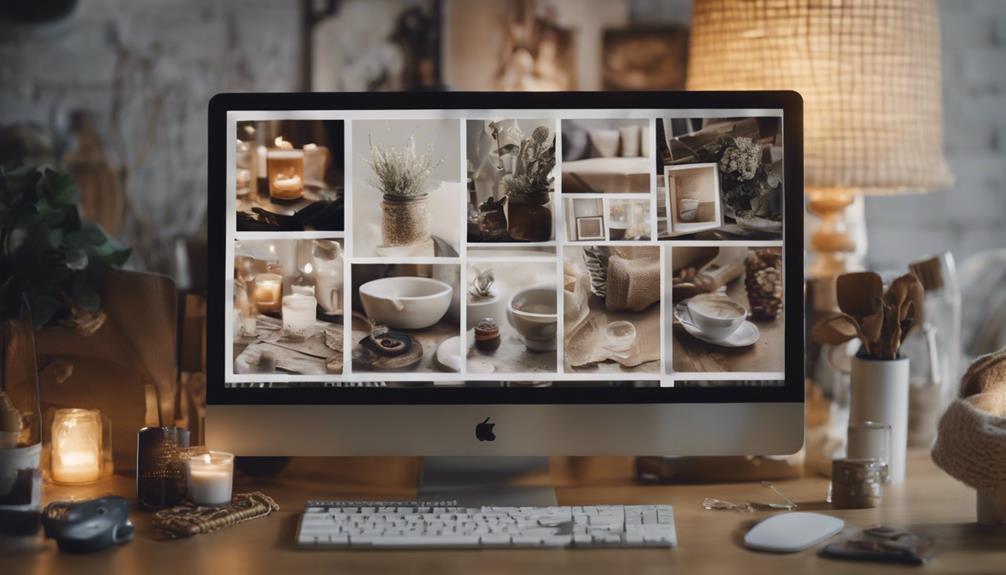
To efficiently track links and prices for your home decor project, set up a Google spreadsheet and Pin sourced items to your Pinterest board.
By creating a dedicated spreadsheet, you can easily input and organize the links and prices of the items you're considering for your mood board. This method allows you to have all the information in one place, making it simple to compare prices and access the online stores when you're ready to make a purchase.
Pinning the items to your Pinterest board not only helps you visualize how they'll fit into your design but also serves as a quick way to access the products when needed.
Enhancing Design With Color
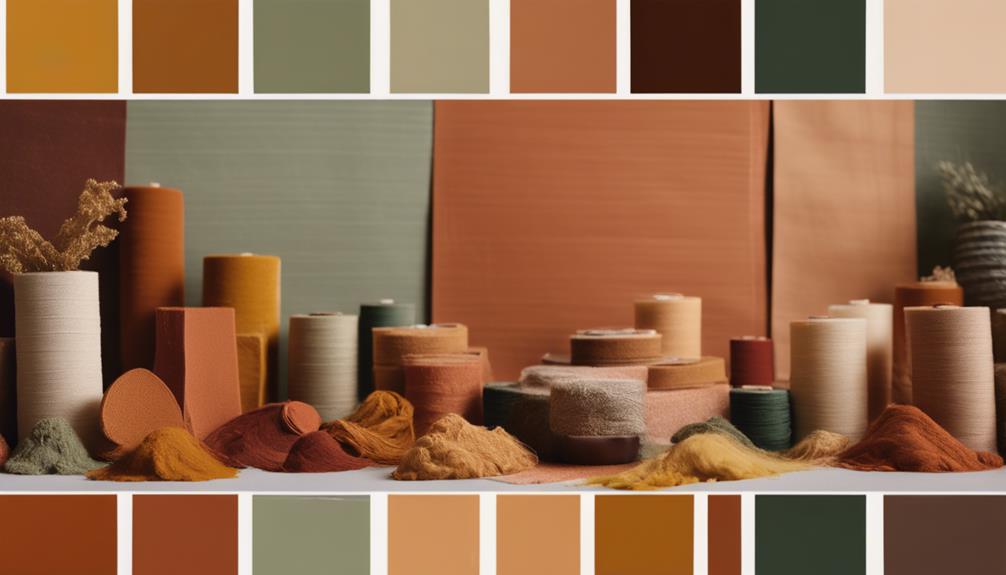
Enhance your home decor design by strategically incorporating colors to create a visually engaging and harmonious space. Color has a profound impact on the mood and perception of a room, making it a powerful tool in interior design. By carefully selecting harmonious color schemes, you can elevate the aesthetic appeal and cohesiveness of your home improvement project.
Understanding the psychology of color is key to choosing the right hues that evoke the desired emotions in each room. Experimenting with a variety of colors in a thoughtful way can completely transform a space, resulting in a visually pleasing environment that resonates with your personal style and vision.
Tools for Designing Mood Boards

In designing mood boards for your home decor project, consider utilizing various tools to streamline the process and keep your design elements organized. Online tools like Canva can be a great asset for creating visually appealing interior design mood boards. With Canva's user-friendly interface, you can easily drag and drop elements to craft the perfect layout for your inspiration.
Additionally, utilizing Pinterest boards as digital mood boards can help you organize design elements efficiently. You can create different boards for various rooms or themes, making it easy to access and share your design ideas.
To keep track of item links and prices for your project, consider using Google spreadsheets. This tool allows you to input and manage information in a structured way, ensuring easy reference during the design process.
Frequently Asked Questions
How to Make a Good Mood Board for Interior Design?
To make a good mood board for interior design, gather textiles, color palettes, furnishings, and other design elements. Use Canva or Pinterest for easy creation and inspiration. Communicate effectively with clients and team members through a visually appealing mood board.
What Program Do Designers Use to Make Mood Boards?
Designers use programs like Canva for a user-friendly experience and Adobe Creative Suite for advanced features. Choose based on familiarity, project needs, and customization preferences to create stunning mood boards that elevate your design game.
How to Create a Mood Board and Apply It to Your Design Plan?
To create a mood board and apply it to your design plan, gather images of textiles, color palettes, and furnishings. Utilize Canva for easy design representation. Use the mood board as a reference point for adjustments and decisions in your home decor project.
How to Make a Vision Board for Home Design?
Like a painter with a blank canvas, start by collecting images, colors, and textures that inspire you. Arrange them on a digital platform like Canva or Pinterest to create a vision board for your home design journey.
Conclusion
Now that you've mastered the art of creating a mood board for your home decor design, you're ready to take your space to the next level.
With the right tools and organization, you can bring your vision to life and create a space that truly reflects your style and personality.
So grab your virtual paintbrush and start designing – the possibilities are endless!
